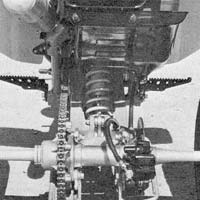
The entire airbox
was removed and replaced by a single
K&N unit. It makes more power, although
it's not the hot ticket in water or
mud. In these situations leave the stock
system on. |

Mild porting and
a cut pipe add to the powerband. It
revs out and pulls much harder than
the stocker. For the Phase 2 Tri-Z a
Bassani pipe and more radical porting
are the key. |

All we did to
the rear end was install an optional
stiffer spring. This is a must for any
fast, big rider. |

With the added
juice and the monked-on suspension,
the tame Tri-Z sheds its skin and turns
into a fire breather. |
|
SOUNDS
COMPLICATED, BUT HOW'S IT WORK?
Let's deal with Phase I first. With the
minor porting, head work pipe mods, filter
grafting, Boyesen reeds and Answer spark
arrester, the docile, semi-hard-hitting
Tri-Z comes alive. There's no power gain
in the slim low-end delivery, but a substantial
boost comes to the mid-range and upper hit.
The power remains tractable like the stocker;
it just slams harder, much harder, and revs
out a good deal further than the showroom
model. Had it come from the factory like
this, we'd have been grinning like idiots.
There's no doubt that the mods make a considerable
difference in the overall power delivery
of the Yamaha. Phase II is completely berserk.
Every particle of noticeable bottom-end
grunting force completely vanishes. A riled,
abrupt attack builds rapidly, slams through
the usable mid-range, and surges directly
into a walloping strike at the upper revs.
Its Pro-like thrust requires delicate throttle
and clutch coordination to stay on top of
the hostile hit. Experienced pilots will
scream in delight; less seasoned riders
will
shiver and curl up at the explosive, light-switch-type
acceleration.
SUSPENSION SONG:
FROM MEEK TO CONTROLLED
Our only complaint with the stock suspension
action is that it's too soft for anything
other than very casual riding. Yamaha's
cure is very simple and effective. They
offer heavier fork springs and a stiffer
rear spring that firm up the action just
right.
Up front the smallish 35mm forks get the
heavy optional springs and a change of internal
damping blood. Drain the standard oil and
replace it with 15-weight fork oil. With
the springs out and the forks collapsed,
set the oil level at 150mm from the top
of the tubes. Setting up the forks this
way, by oil level rather than amount, will
make for more consistent action. Both sides
will have the identical level and, in turn,
work better.
Out back, install
the optional heavier rear spring, and set
the length at 232mm. That's the compressed
length of the spring, or the set length
while the shock is off the machine. Set
the compression damper at #9 and the rebound
at the second click out.
One ride through any gnarlies will quickly
show off the new-found virtues of the Tri-Z's
suspension prowess. Rather than bottoming
and wallowing over whoops, it reacts and
holds a straight line. Jumps, sand dunes
and mud holes can be attacked rather than
cringed at.
SO...
Yamaha has
come up with the technical knowledge and
the parts needed to transform the Tri-Z
from pleasant to exciting. All you have
to do is find someone to do some of the
labor, bolt on a few items, and you're set.
The mods are definitely worth the time and
money invested. Next month look for Phase
III of the Tri-Z update. We're going to
get rad with the engine and some of the
running gear, and, attempt to make it into
a race-winning missile. Stay tuned.
|